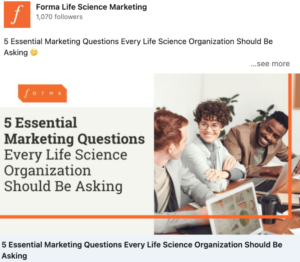3 Vital Types of Social Media Content for Scientific Companies
By Jordan Eller

A key aspect of digital marketing in the life sciences lies in social media. The real-time engagement aspect of social media can transform a science company’s page into its voice, addressing concerns, resolving conflicts, and raising awareness about its brand consistently.
In an industry where online presence is crucial, leveraging social media is not merely an option but a necessity for science orgs aiming to remain relevant and connect with their audience. However, while it’s important to have a consistent posting schedule, it’s equally important to post a wide variety of content. Posting a diverse selection of social content helps your scientific company build its brand identity, address different objectives, diversify its audience, and increase user engagement.
Forma recommends focusing on three types of content. If you can vary your content among these 3 categories, your brand will remain dynamic, interesting, and relevant in the eyes of your followers. The three types of content are:
- Educational Content
- Inspirational Content
- Conversion-focused Content
Educational Content
Educational content on social media goes beyond simply promoting your brand; it informs and adds value to your audience. This type of content spreads information and delivers your brand’s tailored expertise to your audience. Thought leadership is a great example of educational content. Thought leadership involves establishing yourself or a brand as an authority and innovator in a particular industry.
Examples of educational content:
- How-to or step-by-step guides
- Tools and resources
- Explaining a process or strategy
Crafting compelling educational content relies on a strong understanding of your organization’s identity and specific industry. Defining clear objectives for your posts helps organize your topics and ensures a focused and effective message.
It’s advantageous to stay up-to-date with current industry trends and incorporate timely information into your social media posts to remain relevant and engaging. Try to prioritize linking content to relevant events, discussions, and industry trends. This keeps your brand top-of-mind and sends positive trust signals.
Curious about how you can use trust signals to increase your reach on social media? Check out our blog, “Trust Signals: What They Are and How to Use Them”
Inspiring Content
Content that inspires serves to uplift your audience, instilling in them a sense of empowerment and the belief that they can reach their objectives. It not only cultivates a unique brand voice but also cultivates positive connections with your audience.
Examples of inspirational content on social media include:
- Celebrating victories and milestones
- Sharing stories of employee accomplishments
- Posting quotes and motivational messages that resonate with your brand’s values
Strategies for evoking emotions and cultivating a favorable brand image include:
- Storytelling: Narrating authentic and compelling stories about your brand, staff, or clientele can forge strong emotional bonds.
- Engagement and Interaction: Timely responses to comments, messages, and mentions demonstrate approachability and a commitment to your audience. Additionally, interactive elements like polls and quizzes encourage participation and communication.
- Empathy and Social Issues: Addressing challenges and social concerns faced by your audience showcases empathy and solidarity, reinforcing your brand’s values.
Conversion-Focused Content
In contrast to content aimed at brand identity and audience engagement, conversion-centric content is designed to prompt specific actions aligned with your business objectives. The efficacy of conversion-focused content lies in seamlessly integrating your brand voice while directly encouraging actions that benefit your company.
Conversion content provides opportunities to guide your audience toward desired actions, whether it’s making a purchase, subscribing, or endorsing your brand. Aligning content with upcoming promotions or events ensures relevance and effectiveness.
Examples of conversion-focused content include:
- Limited-time offers and promotional campaigns
- Highlighting products or services with clear calls to action
- Showcasing customer testimonials and reviews
By incorporating clear calls to action, you can prompt your audience to take desired actions such as purchasing, subscribing, or engaging further with your content.
Even though Forma doesn’t offer physical products, our goal is to promote and sell our marketing services within the life science industry. Ensuring alignment between your offerings and your brand identity is crucial for effective promotion.
Start posting!
In the ever-evolving landscape of social media, where attention spans are short and trends transient, offering a diverse range of content is essential. Educational, inspirational, and conversion-focused content each plays a vital role in engaging your audience and shaping your brand image.
By varying the types of content you share, you establish a dynamic brand presence that resonates with a broader audience. Experimentation with different content formats is key to maintaining relevance and maximizing engagement in today’s digital arena.







